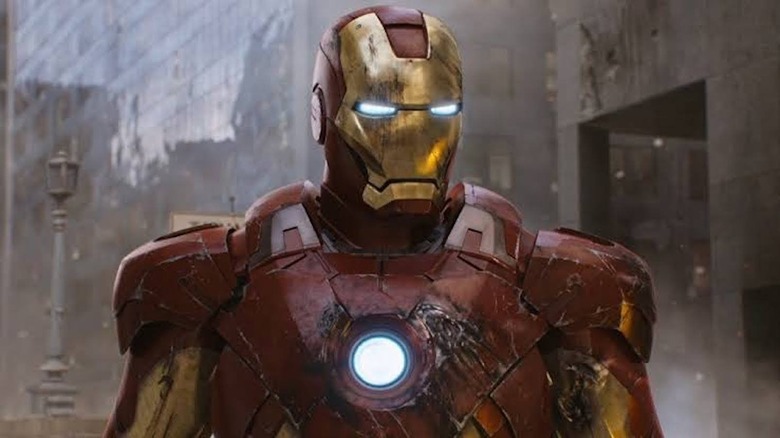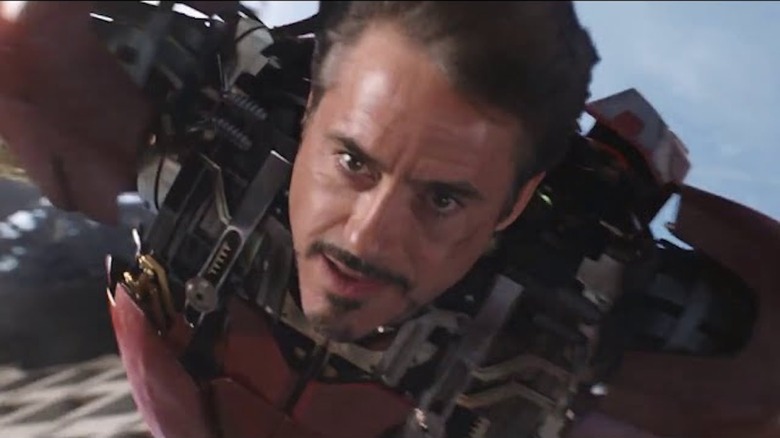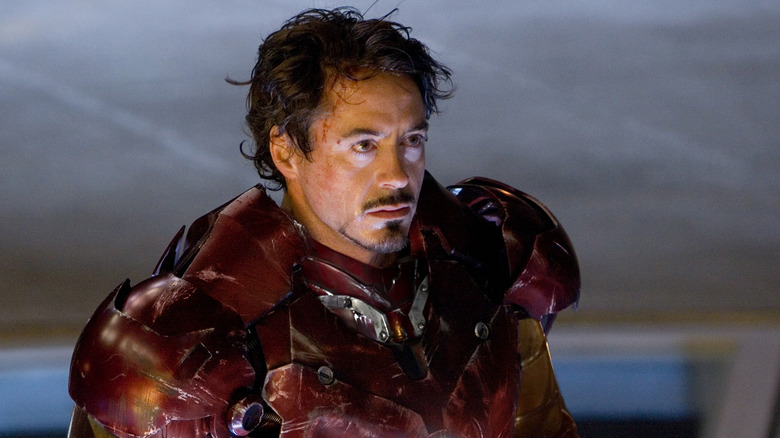Tony Stark's Mid-Air Iron Man Suit-Up In Marvel's Avengers Had To Be Reverse-Engineered
We may receive a commission on purchases made from links.
2012's "The Avengers" represents the moment when the MCU officially claimed box office primacy throughout much of the planet. By the end of its theatrical run, it stood as the third highest grossing film of all time worldwide behind the James Cameron duo of "Avatar" and "Titanic," and, most importantly for Marvel Studios, served as a pump-primer for the Infinity Saga, which would culminate seven years later with "Avengers: Endgame" — currently the second highest grossing film of all time worldwide.
The studio's not-so-secret formula was basically threefold: a) cast charismatic actors, b) hire writers and directors with some degree of reverence for the Marvel universe and c) once moviegoers were hooked, give 'em the slam-bang, galaxy-spanning, eye-popping goods.
That last element required the films' various design teams — including sets, costumes and visual f/x — to get on the same aesthetic page and throw what was once believed impossible onto the big screen. Fortunately, by the time Jon Favreau kicked off the MCU's astonishing 11-year run with 2008's "Iron Man," CG could be, in many cases, seamlessly integrated into live-action films (thanks in large part to pre-visualization, which gives directors a shot-by-shot roadmap that will later be adorned/augmented in post-production by the multi-house visual f/x team). To their credit, Marvel went as big as possible, and delivered to the audience's satisfaction.
This wasn't always easy, and oftentimes forced the visual f/x artists to think and work counterintuitively, but they pulled it off. And, in some cases, it sounds like they had a blast doing it.
How to armor up a plummeting Tony Stark
According to Jason Surrell's "Marvel Studios' The Infinity Saga – The Avengers: The Art of the Movie," one such complication arrived during the post-production of "The Avengers." According to concept artist Phil Saunders, director Joss Whedon presented him the challenge of retaining the feel of the Mark V suitcase suit (introduced in "Iron Man 2"), while giving Tony Stark's armor a "bulkier, fully armored silhouette."
As Saunders told Surrell:
"There is a scene in 'The Avengers' where Tony is thrown out the window of his office tower – and a cruise missile-like package flies after him, unfolds and wraps itself around him as the Mark VII suit. While I kept that ultimate goal in mind while designing the suit. I didn't tackle that until the suit was designed and modeled so that it wouldn't compromise the ultimate design of our hero."
This is the prelude to the climactic Manhattan battle, where Stark confronts Loki (building New York City in "The Avengers" was a gargantuan labor unto itself). This had to be a small fist-pump moment to juice the audience for what was in the offing, so Saunders and the animators took great care in getting it right. Per Saunders:
"In a process of reverse-engineering, I was able to take Josh Herman's amazing digital model, import it into Luxalogy Modo, break it into components and figure out an articulation that would allow it to collapse into a missile-like shape."
This all sounds terribly impressive (even if you wouldn't know Luxalogy Modo from the Luxor Hotel & Casino), but, amazingly, Saunders' job wasn't quite finished.
Making every one and zero count for Iron Man's suit
In mega-budget films like "The Avengers," there's an expectation that the filmmakers will keep a close eye on the nuances of a major f/x sequence. Because it's the little things that we might not notice on a first, second or even third viewing that complete the illusion and keep the viewer fully engaged in this meticulously manufactured world.
With this in mind, Saunders topped off the sequence thusly:
"With a basic animation and a final collapsed silhouette, I added panels to streamline the form – using as many of the actual suit surfaces as possible so as to hint at what the mysterious package would eventually become. Those panels would ultimately blow off like the shield plates on an ICBM before the suit unfolds, adding another dynamic element to the sequence."
The vast majority of CG ages poorly, but this scene is so busy and happens so quickly that you don't have time to question the artifice. You can rewatch it over and over, and definitely see every element rendered precisely as Saunders explains it in the book. "The Avengers" might've been a preordained blockbuster, but people still watch it today because it's well executed on every level. I think Marvel has slacked off a bit post-Infinity Saga (which may have to do with executive indecision on the direction of the overall franchise), but they almost always hit the mark up until 2019.


